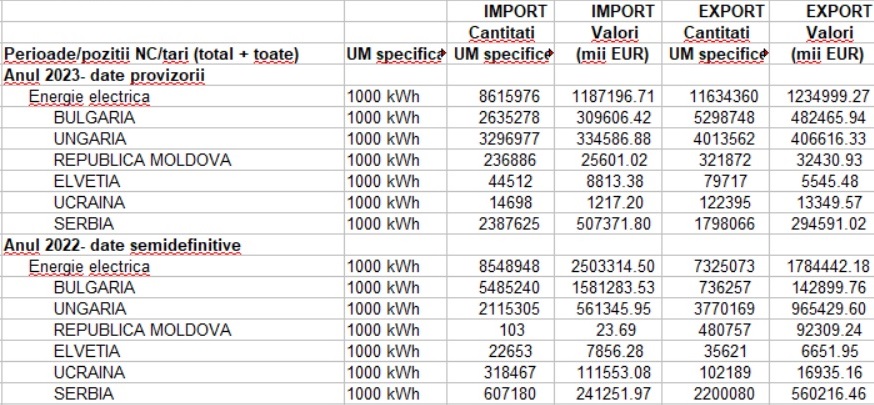
“Romania has become a net energy exporter,” government representatives boast when they have the chance. “And we will continue to export, Romania will strengthen its status as a regional leader in the energy sector,” the energy minister said recently. Sebastian Burduzha. But he avoids saying that these exports are far from becoming more profitable than imports. In short, according to statistics requested by HotNews.ro, we bring more expensive energy into the country than what is sent across the border.
The value of exports did not increase in proportion to the quantity
In 2023, we exported energy at an average of EUR 106.1/MWh and imported energy at an average of EUR 137.7/MWh. This means that imports were about 23% more expensive than exports, and this percentage difference was greater even compared to the previous year, at the height of the energy crisis.
In 2022, we imported energy to the country for 292.8 euros/MWh, and exported an average of 243.6 euros/MWh, i.e. imports were 17% more expensive.
What prompts the authorities to claim that Romania has become a net exporter is the fact that, quantitatively, we sold much more energy across the border than in 2022. More precisely, last year we exported 11.6 million MWh compared to only 7.3 million MWh.
However, in total export value, it decreased from 1.7 billion euros in 2022 to 1.2 billion euros.
In practice, Romania earned less from exports, although it sold much larger volumes. This and in conditions where electricity has become very cheap on international markets, the reduction reaches more than 90%. For example, in the spot markets, at the height of the energy crisis, a MWh of energy reached a record level of more than 550-600 EUR/MWh. Now there are days when it is sold for 50 euros/MWh.
On the import side, there were no significant changes in volume, the difference is very small: 8.6 million MWh in 2023 versus 8.5 million MWh in 2022.
In value terms, we imported 1.18 billion euros last year, compared to 2.5 billion euros, amid significant energy discounts.
Where do we import from and where do we export from / More coordinated business with Switzerland than with Ukraine
The Romanian spot market is combined with the markets of Hungary, the Czech Republic and Slovakia, Austria, Poland and Germany. Theoretically, Romania can carry out energy transactions with many European countries.
According to INS data, last year we imported the most from Hungary (3.3 million MWh), and exported the most to Bulgaria (5.3 million MWh).
Significant transactions also took place with Serbia, where Romania imported 2.3 million MWh, which is significantly more than in 2022, when volumes did not exceed 607 thousand MWh. Imports to Serbia were also the most expensive, averaging €212/MWh. At the same time, we exported 1.7 million MWh from Serbia at EUR 163/MWh.
Romania also has commercial electricity exchanges with Switzerland, even more stable than with its Ukrainian neighbors. So, last year we imported 44.5 thousand MWh from Switzerland for the amount of 8.8 million euros against 14.6 thousand MWh for the amount of 1.2 million euros from Ukraine. Commercial relations with Ukraine are often associated with emergency supplies from Romania. Against the background of the war with Russia, Ukraine several times came to the situation when, due to the shortage of the energy system, it asked for emergency help from Romania.
We exported 79.7 thousand MWh to Switzerland, the cheapest price was only 67 EUR/MWh.

Why do we import expensively and export cheaply?
At the moment, Romania does not have a functional free market where long-term contracts can be concluded at favorable prices, moreover, there are no price signals and exports are made when there is excess energy on the grid. In particular, it exports when it does not need all the energy it produces, which is usually when prices are low. Prices on the spot markets with which Romania is connected are taken into account.
When there is too much capacity and demand is low, usually at night, the price goes down, and when demand is high, the price goes up. When demand increases and the need for imports increases, this explains why they are produced at higher prices.
We do not have a functioning market where it is fully regulated by price capping schemes. Only now, although the consequences of the energy crisis have not been felt for almost a year, the Romanian government is raising the issue of releasing a certain amount of energy to the free market, to the stock exchange, to form price signals. In this sense, the draft amendment to GEO 27/2022 regarding the compensation limitation scheme has been submitted for public discussion. But even in this case, the market will not be completely free, as the government intends to extend for a year the restrictions for the final consumer to a lower level than the current ones.
Exports also increased against the background of increased production, but also lower consumption at the national level. Net electricity production last year increased by 2.7%. At the same time, net domestic consumption decreased by 5.2%. Consumption in the economy fell by 4.1%, which is not exactly good news, it could mean that we have a weaker industry, not necessarily more efficient consumption.
Source: Hot News
Lori Barajas is an accomplished journalist, known for her insightful and thought-provoking writing on economy. She currently works as a writer at 247 news reel. With a passion for understanding the economy, Lori’s writing delves deep into the financial issues that matter most, providing readers with a unique perspective on current events.